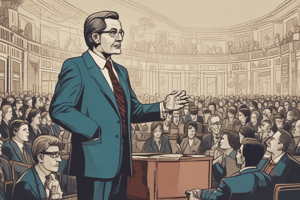Podcast
Questions and Answers
What are three common ways narratives are sequenced? (Select all that apply)
What are three common ways narratives are sequenced? (Select all that apply)
- As a flashback (correct)
- Reverse chronological order (correct)
- As an anecdote
- Chronological order (correct)
The author uses a flashback in the Terry Tempest Williams example to illuminate the larger narrative.
The author uses a flashback in the Terry Tempest Williams example to illuminate the larger narrative.
True (A)
What is the most obvious time marker used in narratives?
What is the most obvious time marker used in narratives?
Time markers
Flashcards
Rhetorical Situation
Rhetorical Situation
The elements that influence a writer's choices, including the message, audience, and context.
Narratives
Narratives
Stories used to support or enhance a piece of writing.
Sequencing
Sequencing
Arranging events in a specific order within a story.
Chronological Order
Chronological Order
Signup and view all the flashcards
Reverse Chronological Order
Reverse Chronological Order
Signup and view all the flashcards
Flashback
Flashback
Signup and view all the flashcards
Time Markers
Time Markers
Signup and view all the flashcards
Transitions
Transitions
Signup and view all the flashcards
Pertinent Details
Pertinent Details
Signup and view all the flashcards
Background Information
Background Information
Signup and view all the flashcards
Opening with Narratives
Opening with Narratives
Signup and view all the flashcards
Closing with Narratives
Closing with Narratives
Signup and view all the flashcards
Purpose (Rhetorical Situation)
Purpose (Rhetorical Situation)
Signup and view all the flashcards
Audience (Rhetorical Situation)
Audience (Rhetorical Situation)
Signup and view all the flashcards
Genre (Rhetorical Situation)
Genre (Rhetorical Situation)
Signup and view all the flashcards
Stance (Rhetorical Situation)
Stance (Rhetorical Situation)
Signup and view all the flashcards
Media/Design (Rhetorical Situation)
Media/Design (Rhetorical Situation)
Signup and view all the flashcards
Study Notes
Rhetorical Situation in Narratives
- Understanding your purpose for writing affects how you explain a process. A persuasive argument will differ from a how-to guide.
- Consider your intended audience and whether background information is necessary to engage them.
- Different genres (e.g., lab reports, profiles) require varying approaches to explanation.
- The chosen medium (print, web) impacts presentation.
- Narratives, as story-telling, can enhance most writing types.
- Narratives must support the overall purpose, not be added merely for interest.
- Narratives are meticulously crafted, sequenced, and detailed, ensuring they align with the author's rhetorical situation.
Sequencing in Narratives
- Narratives commonly use chronological order (beginning to end).
- Reverse chronological order (ending to beginning) is also used, especially in summaries or retrospectives.
- Flashbacks are employed to insert relevant prior events into the narrative flow.
Including Pertinent Detail in Narratives
- Be selective with narrative details; avoid distracting from the main text.
- Background information is sometimes needed, depending on the audience and purpose of the work.
- Narratives can introduce a topic or conclusion.
- Consider the specific needs and expectations of your intended audience.
Opening and Closing with Narratives
- Start an essay or piece with a narrative to capture attention
- Powerful anecdotes can introduce complex or non-engaging subjects effectively.
- End a work with a narrative to emphasize key points or illustrate a conclusion.
- Consider the target audience and genre's requirements when including narratives.
Time Markers in Narratives
- Chronological ordering of events is crucial for understanding timelines.
- Transitions (e.g., first, then, meanwhile) guide readers through events or actions.
- Use time markers (dates, days) to signal passing time within a narrative.
Studying That Suits You
Use AI to generate personalized quizzes and flashcards to suit your learning preferences.




